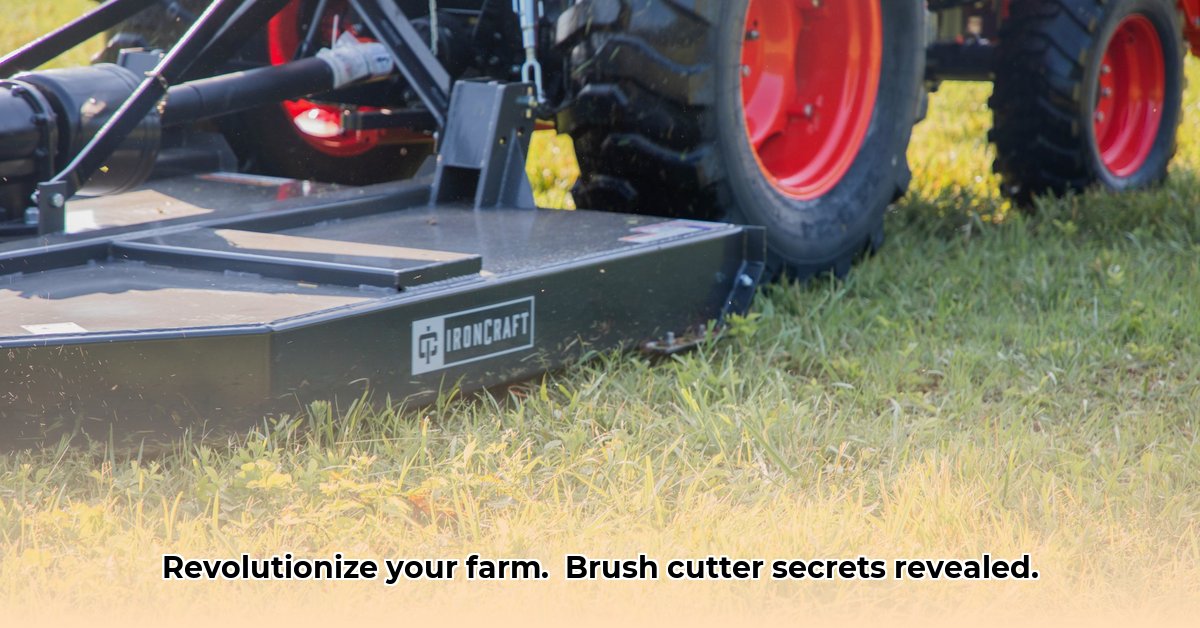
Choosing the right brush cutter for your farm is crucial for efficient land management and sustainable agriculture. This guide provides actionable steps to select, use, and maintain a brush cutter, minimizing environmental impact while maximizing productivity. For Kubota tractor owners, check out this helpful resource on mulcher options.
Understanding Rotary Cutters: Essential Tools for Sustainable Land Management
Rotary cutters, also known as brush cutters, are powerful attachments for tractors, efficiently clearing brush, preparing land for planting, and improving soil health. They are versatile tools applicable across a range of farming practices and terrains. However, effective utilization requires careful consideration of several factors.
Selecting the Right Brush Cutter: A Step-by-Step Approach
Choosing the perfect brush cutter involves matching your needs with available models. Consider these key factors:
Tractor Compatibility: Ensure your tractor possesses sufficient horsepower for the chosen brush cutter. Underpowering leads to inefficiency and potential damage; overpowering is wasteful.
Cutting Width: Wider cutters cover more ground per pass, increasing speed but potentially hindering maneuverability in confined spaces. Narrower cutters offer precision for smaller areas and intricate work.
Cutting Height Adjustment: The ability to adjust cutting height allows precise control over the amount of vegetation left behind, influencing organic matter incorporation and soil health.
Terrain Suitability: Rugged terrains demand durable brush cutters capable of withstanding stress. A sturdy construction is therefore essential for uneven land.
Budgetary Considerations: Brush cutters vary significantly in price. Establishing a budget beforehand prevents overspending and ensures a practical choice.
“Choosing the right cutter is akin to selecting the right surgical instrument for a procedure,” says Dr. Anya Sharma, Agricultural Engineer at the University of California, Davis. “Precision and matching the tool to the task are paramount for optimal results.”
Rotary Cutters and Sustainable Farming: Balancing Productivity and Environmental Stewardship
While rotary cutters offer significant advantages, understanding their potential environmental impact is crucial for sustainable operation.
Advantages and Disadvantages of Brush Cutter Usage
| Advantages | Disadvantages |
|---|---|
| Accelerated land clearing and preparation | Potential soil compaction and increased erosion |
| Improved soil aeration and organic matter incorporation | Higher fuel consumption compared to some alternatives |
| Versatile adaptability across various terrains and crops | Significant initial investment |
| Enhanced efficiency and reduced labor needs | Regular maintenance and potential repair costs |
“The key to sustainable brush cutter use lies in informed decision-making and responsible application,” notes Professor David Miller, Extension Specialist in Sustainable Agriculture at Purdue University. "Ignoring potential downsides can negate many of the benefits."
Sustainable Brush Cutter Practices: A Guide to Responsible Land Management
Implementing best practices ensures the environmental benefits of brush cutter usage outweigh any negative impacts.
Optimizing Brush Cutter Usage for Sustainable Farming
Soil Assessment: Prioritize understanding your soil type, drainage characteristics, and erosion susceptibility before commencing any cutting operation.
Cutter Selection for Soil Type: Select a cutter design suitable for your specific soil conditions. Heavy-duty models for challenging terrains, lighter models for loose soil.
Controlled Cutting Depth: Avoid excessive cutting depth to prevent soil damage and promote the retention of surface residue.
Crop Rotation Strategies: Implementing crop rotations diversifies the land use, often reducing the necessity for extensive brush cutting.
Exploring Alternative Methods: Consider reduced-tillage or no-till farming approaches alongside brush cutting to minimize disturbance to the soil profile.
Equipment Maintenance: Rigorous maintenance minimizes breakdowns, ensuring efficient cutter performance and prolonged lifespan, reducing the environmental costs of frequent replacements.
"A well-maintained brush cutter is a key component of both successful and sustainable farming operations," emphasizes Dr. Emily Carter, Soil Scientist at the USDA Agricultural Research Service. "Neglecting maintenance directly translates to losses in both efficiency and environmental protection."
Long-Term Sustainability: Beyond the Initial Investment
The long-term sustainability of your farming practices is inextricably linked to the equipment you use and how you use it.
Factors to Consider for Sustainable Long-Term Use
Fuel Efficiency: Prioritize fuel-efficient models to curb operating costs and reduce your farm's carbon footprint.
Maintenance Costs: Budget appropriately for regular maintenance, including blade sharpening, oil changes, and potential repairs, to maintain efficiency and longevity.
Equipment Lifespan: Investing in a durable and high-quality cutter minimizes the need for frequent replacements, reducing both costs and environmental impact.
"Sustainable farming necessitates thinking beyond immediate returns," concludes Mark Johnson, farmer and owner of Green Valley Farms. "Long-term equipment investment and diligent maintenance are integral to environmental responsibility and overall farm profitability."
By integrating these practices, farmers can significantly achieve the benefits of brush cutters while minimizing negative environmental consequences, promoting both efficient land management and sustainable agricultural practices.